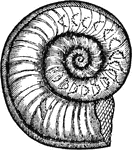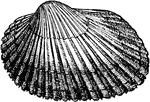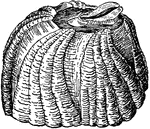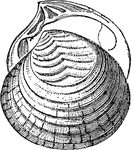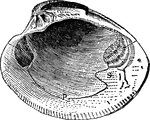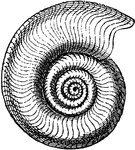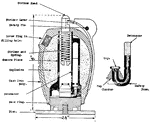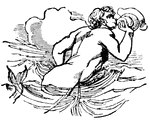
Iphigenia Brasiliensis - Sinupalliate Right Valve
"Having a sinuous pallial margin and consequent sinuous impression on the shell along the line of attachment…
Accessory Valve
"Small additional valves, as those placed near the umbones of the Genus Pholas among mollusks."-Whitney,…

Acera
"A genus of mollusks, of the familiy bullidæ or Tornatellidæ, belonging to the tectibranchiate…

Aetheria semilunata
"A genus of bivalve mollusks, of the family Uniondæ, found in the rivers of Africa and Madagascar."-Whitney,…

American Grenades
A hand grenade is a small hand-held anti-personnel weapon designed to be thrown and then explode after…

Ammon's Horn (Shell)
An illustration of an Ammon's Horn shell, a fossil shell, curved like a ram's horn. A name previously…

Ammonite
"Ammonite is the name for a large genus of fossil chambered shells."—(Charles Leonard-Stuart,…

Ammonite
"Ammonite is the name for a large genus of fossil chambered shells."—(Charles Leonard-Stuart,…
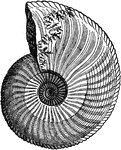
Ammonite
Ammonite, side view. Where the shell has been partly worn away near the aperture, the complex "suture…
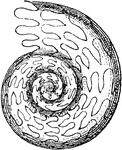
Ammonoid
"Goniatites henslowi. GONIOTITES. A genus of fossil ammonites, giving name to the family Goniatitidae,…

Armor-Piercing Shell
"Armor-piercing shells are projectiles so constructed as to bore through the metallic plates with which…

Armor-Piercing Shell
"Armor-piercing shells are projectiles so constructed as to bore through the metallic plates with which…
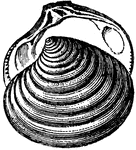
Astarte sulcata
"Astarte sulcata; In some systems of zoological classification, a family of dimyarian bi-valves, an…
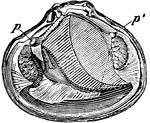
Astarte sulcata
"Astarte borealis semisulcata. p,p', anterior and posterior pedal muscle."-Whitney, 1902.

Ball-bearing Hub
"A ball-bearing hub with outward cups. The hub-shell H is turned out of mild steel, and the cups C are…
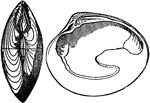
Bivalve
"Bivalves are those mollusks whose coverings consist of two concave shelly plates or valves united by…

40 Pound Mortar Stick Bomb Shell
An illustration of a 40 pound mortar stick bomb shell. The shell have three wings, or vanes, around…

99 Pounds Mortar Stick Bomb Shell
An illustration of an early 99 lb. stick bomb used in a mortar. This bomb had vanes, or wings, around…

Brachiopod
A Paleozoic brachiopod shell partly broken to show the internal spiral arm-supports. Mississippian limestones.…

Curved buccina
"The buccina is curved for the convenience of the performer, with a very wide mouth, to diffuse…
Straight buccina
"A copy of an ancient sculpture taken from Blanchini's work, it still retains the original form of the…
Cephalopod
A simple straight-shelled cephalopod. Where the shell has been removed, the straight sutures are shown.

Chelys
"Chelys, from a vase in the British Museum, where also are fragments of such an instrument, the back…
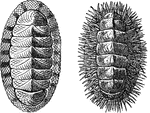
Chitonidæ
They differ from all other mollusks in having a bilaterally symmetrical covered with a number of seperate…

Chrysalidina Gradata
This illustration shows the calcareous shell Chrysalidina gradata. These shells are mostly very small,…
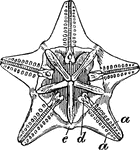
Clypeastrid
A family of irregular sea urchins, flattened into a discoidal or shield like shape, with a mouth central…
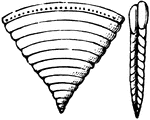
Cuneolina Pavonia
This illustration shows the calcareous shell Cuneolina pavonia. These shells are mostly very small,…
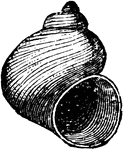
Cyclonema Mollusk
A mollusk radiate from the Paleozoic time, Cyclonema cancellata from the Clinton group.
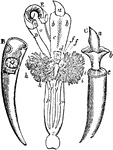
Dentalium
"Dentalium: B, the shell of Dentalium Entalis, broken longitudinally, showing the animal in a contracted…

Ear-shell
"In these, which are called Ear-Shells, the animal has a shrt muzzle and two branchial plumes;…

Escalop
"ESCALOP. The shell of a sea-fish, used to decorate the palmers on their way to and from Palestine;…
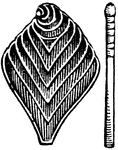
Flabellina rugosa
This illustration shows the calcareous shell Flabellina rugosa. These shells are mostly very small,…

French Grenade (C.F.)
This grenade consists of three parts: (1) a lemon-shaped, serrated, cast iron body; (2) a special igniter…
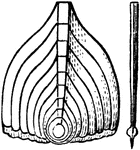
Frondicularia Annularis
This illustration shows the calcareous shell Frondicularia Annularis. These shells are mostly very small,…

Fu'sus
Fu'sus is a genus of gastropods, which are allied to the British whelk and American conch, and which…
Fusulina Cylindrica
This illustration shows the calcareous shell Fusulina cylindrica. These shells are mostly very small,…
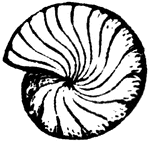
Fusulina Cylindrica
This illustration shows the calcareous shell Fusulina cylindrica. These shells are mostly very small,…

Dorsal View of Gastrochaena
"Dorsal View of Gastrochaena. The ventral view shows the dried mantle with pedal perforation." -Whitney,…

Lateral View of Gastrochaena
"Lateral View of Gastrochaena. The ventral view shows the dried mantle with pedal perforation." -Whitney,…

Ventral View of Gastrochaena
"Ventral View of Gastrochaena. The ventral view shows the dried mantle with pedal perforation." -Whitney,…
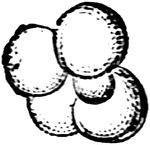
Globigerina Rubra
This illustration shows the calcareous shell Globigerina rubra. These shells are mostly very small,…

Grammostomum Phyllodes
This illustration shows the calcareous shell Grammostomum phyllodes. These shells are mostly very small,…
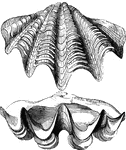
Shells of the great clam
"The Giant Clam, Tridacna gigas, is the largest of known shell-fish, the two valves sometimes…
